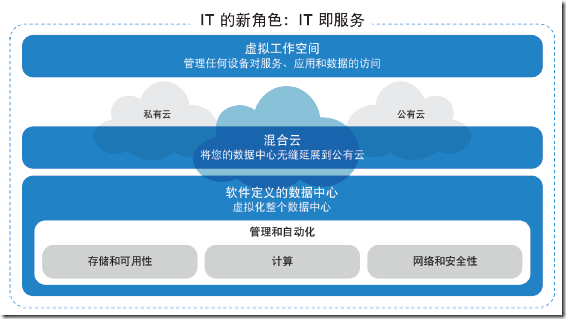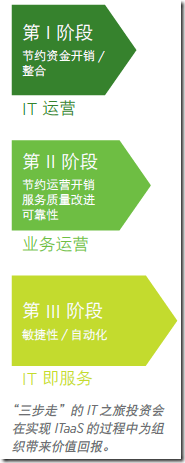Build a VMware private cloud
If your organization has already enjoyed the cost savings brought about by server virtualization, imagine that if you extend virtual computing to all applications, and even to storage and networking, then the benefits will be "nothing to add." When relying on VMware and the huge VMware system to implement virtualization, enterprises will obtain excellent architecture, technology, and services to realize a software-defined data center.
More than ten years ago, VMware introduced the VMware vSphere virtualization platform to help companies reduce IT complexity and costs.
VMware now ranks third on the Forbes "Most Innovative Companies" list4. By enabling faster and easier application and resource deployment, VMware and its partners' technologies can increase the agility of IT and business departments. They provide a very flexible pool of computing, storage, and network resources through software, thereby improving IT control. In addition, they also eliminate the problem of operational inefficiency, so that your organization can free existing IT resources from project maintenance and redistribute them to business innovation. However, everyone who relies on technology understands that the times are always changing. Therefore, the VMware partner network with many members of VMware provides a practical step-by-step method for accelerating the development of IT in the "mobile-cloud computing" era. From data centers to virtual workspaces, VMware and its partner system are pushing IT departments to achieve the following key tasks:
Software-defined data center—Through an open architecture approach, the cost and operational advantages of server virtualization are extended to all data center infrastructure (computing, network, security, and storage); at the same time, automation solutions are added to enable IT departments Able to keep up with the pace and needs of the business department
Hybrid cloud — Provides a common management, orchestration, network and security model, seamlessly expands the data center to the cloud and supports existing and next-generation applications, and improves enterprise agility
Mobility — Brings the freedom, flexibility, and management advantages of virtualization to organizations that need to support multi-device users who travel frequently.
I also mentioned before that the virtualization construction of an enterprise needs to take five steps. When the enterprise completes the virtualization construction and investment, then, in fact, the enterprise is slowly walking like its own private cloud or hybrid cloud era. To achieve the construction of a private cloud, it also needs to take a step-by-step approach, and finally achieve IT as a service (IT as a service).
"IT as a Service" (ITaaS) gives employees and IT departments autonomy. While personalizing IT delivery, ITaaS can minimize technical overhead, training, and redundant processes, and maximize IT agility, flexibility, responsiveness, and control. Thanks to ITaaS, IT teams no longer need to passively respond to endless demands, and instead actively establish cooperative relationships with business departments. As a strategic service intermediary, IT departments can more effectively meet demand and help companies establish a competitive advantage. But how can we improve business agility and revenue without pushing up costs?
The first stage: saving capital expenditure/integration, some enterprises are still running their business on the traditional IT architecture, then, the enterprise must complete the migration from the traditional IT architecture to the virtualization platform, and complete the five steps of virtualization Taking virtualization as the foundation of cloud computing can help save billions of dollars while innovating and developing. Because VMware virtualization and automation software extends from the entire data center to the virtual workspace, we can radically simplify IT to support your unique business goals.
The second stage: Save operating expenses, improve service quality, and improve reliability. At the beginning of this journey, many companies usually virtualize their infrastructure first in order to consolidate investment and reduce costs. Later, they will virtualize key business applications and adopt a strategy that takes full advantage of automation and advanced management capabilities to expand virtualization.
Extend beyond the computing platform and extend it to the rest of the infrastructure, including storage, networking, and security. These tasks can reduce operating costs and improve service quality. However, only when virtualization becomes truly ubiquitous, your business can finally fully realize the value of ITaaS.
The third stage: Realize IT as a service and build a cloud platform with agility and automation. The VMware private cloud solution is based on VMware vCloud Suite. With similar abstraction capabilities as in VMware vSphere, it can elevate virtualization to the data center level. IT services are delivered in fully encapsulated and removable multi-virtual machine units that can be stored in the service catalog and can be migrated to any VMware-compatible cloud. Control and manage the resource usage of end users through the following two aspects: role-based access policies tied to the organizational structure, and unique virtual network connection technologies that support the concurrent deployment of similar virtual machine environments.
Redefining IT infrastructure: the software-defined data center
Extend virtual computing to increase agility
As an ideal architecture suitable for private cloud, public cloud or hybrid cloud, the software-defined data center extends the power of virtualization and automation to all data center services (storage, network and security), bringing unprecedented efficiency and agility And control. In this environment, every mission-critical application, every database, every big data application, and every physical server is replaced by a virtual infrastructure. VMware vCloud Suite and VMware vSphere with Operations Management are ideal virtualization platforms for extending computing to all applications.
Realize storage transformation to reduce costs and improve performance
However, applications need data and data must be stored. Therefore, VMware and industry-leading storage technology partners provide a three-part architecture for software-defined storage. The first part is a policy-driven control layer in which IT staff can set policies for capacity, performance, and availability requirements based on the number of virtual machines, and then the rest of the virtual infrastructure executes these policies. The second part is the virtualization of the data layer, which allows IT personnel to abstract and pool various functions of the underlying storage infrastructure, and then distribute these functions to the software-driven control layer. The last part is the virtualization of application-centric data services. These services have been tightly bound to the hardware array, so they can support rich virtualized data services.
The VMware Virtual SAN environment can extend the hypervisor to use local storage and flash memory technology as a new aggregated infrastructure data storage layer to pool computing and storage. In this environment, policy is tightly integrated with the virtualization layer. Moreover, the environment is very flexible. High-performance Virtual SAN utilizes local storage and local read/write cache in virtual machines to reduce costs and improve storage performance, especially for enterprises that require virtual desktop infrastructure, branch network connections, and third-tier storage.
Realize network virtualization to increase speed and efficiency
After the storage can meet the application requirements, you can start to virtualize the network to improve speed and efficiency, so that customers and employees have a better experience. You can abstract network functions away from the underlying hardware, freeing the workload from the physical network infrastructure and freeing IT staff from the slow and error-prone provisioning process. Through a software-defined model, you can transform the way the network operates, make it programmatic and automated, and help improve the agility of the IT department.
According to the design, VMware NSX supports any application, any cloud computing management system, any hypervisor and any network hardware. Just as VMware ESX completely changed the computing field, NSX is also changing network operations and computing in the same way. With the help of NSX to virtualize your network, you can accelerate application deployment, reduce capital and operating costs, and transform network operations in a non-disruptive manner.
Realize automation and liberate resources
For a data center that adapts to the future, the key is to automate IT operations management. Traditional IT management has spawned isolated information and infrastructure small environments; automated cloud computing management can provide a control panel view that contains operational guidance. IT can better manage security, compliance, and risk while driving business value. The automated management solutions provided by VMware and its partners can support more virtual machines, more events, and more complex interactions with powerful policy-driven tools. These solutions can simplify IT management across physical infrastructure, multiple virtual environments, and multiple cloud environments, and enable the IT department to transition from an implementer to a strategic partner within the enterprise. The breadth and depth of VMware solutions in driving automation and IT management improvements is unparalleled, which provides opportunities for IT departments to truly act as service intermediaries throughout the organization. According to a recent IDC report, VMware ranks first in the field of cloud computing management.
With a software-defined data center, your business can move into the future without being dragged down by applications. You can get rid of the constraints of the "complex" operating system and return control to the IT department. The most commendable point is that in the journey to ITaaS, you can choose the virtualization path that is most beneficial to the organization.





